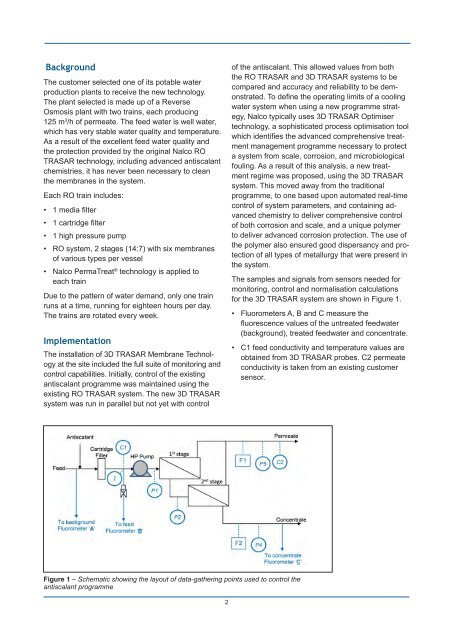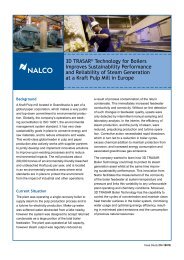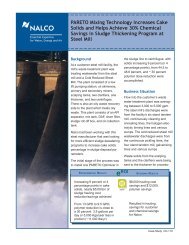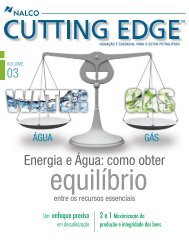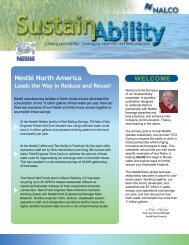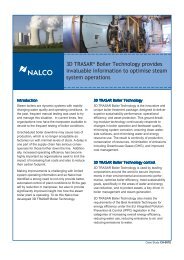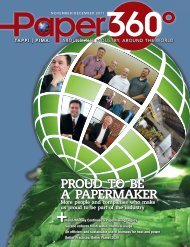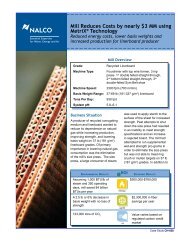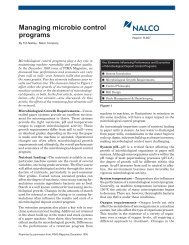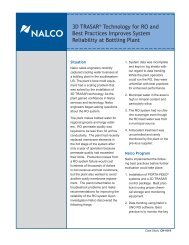New 3D TRASAR® Membrane Technology increases plant ... - Nalco
New 3D TRASAR® Membrane Technology increases plant ... - Nalco
New 3D TRASAR® Membrane Technology increases plant ... - Nalco
You also want an ePaper? Increase the reach of your titles
YUMPU automatically turns print PDFs into web optimized ePapers that Google loves.
Background<br />
The customer selected one of its potable water<br />
production <strong>plant</strong>s to receive the new technology.<br />
The <strong>plant</strong> selected is made up of a Reverse<br />
Osmosis <strong>plant</strong> with two trains, each producing<br />
125 m 3 /h of permeate. The feed water is well water,<br />
which has very stable water quality and temperature.<br />
As a result of the excellent feed water quality and<br />
the protection provided by the original <strong>Nalco</strong> RO<br />
TRASAR technology, including advanced antiscalant<br />
chemistries, it has never been necessary to clean<br />
the membranes in the system.<br />
Each RO train includes:<br />
• 1 media filter<br />
• 1 cartridge filter<br />
• 1 high pressure pump<br />
• RO system, 2 stages (14:7) with six membranes<br />
of various types per vessel<br />
• <strong>Nalco</strong> PermaTreat ® technology is applied to<br />
each train<br />
Due to the pattern of water demand, only one train<br />
runs at a time, running for eighteen hours per day.<br />
The trains are rotated every week.<br />
Implementation<br />
The installation of <strong>3D</strong> TRASAR <strong>Membrane</strong> <strong>Technology</strong><br />
at the site included the full suite of monitoring and<br />
control capabilities. Initially, control of the existing<br />
antiscalant programme was maintained using the<br />
existing RO TRASAR system. The new <strong>3D</strong> TRASAR<br />
system was run in parallel but not yet with control<br />
Figure 1 – Schematic showing the layout of data-gathering points used to control the<br />
antiscalant programme<br />
2<br />
of the antiscalant. This allowed values from both<br />
the RO TRASAR and <strong>3D</strong> TRASAR systems to be<br />
compared and accuracy and reliability to be demonstrated.<br />
To define the operating limits of a cooling<br />
water system when using a new programme strategy,<br />
<strong>Nalco</strong> typically uses <strong>3D</strong> TRASAR Optimiser<br />
technology, a sophisticated process optimisation tool<br />
which identifies the advanced comprehensive treatment<br />
management programme necessary to protect<br />
a system from scale, corrosion, and microbiological<br />
fouling. As a result of this analysis, a new treatment<br />
regime was proposed, using the <strong>3D</strong> TRASAR<br />
system. This moved away from the traditional<br />
programme, to one based upon automated real-time<br />
control of system parameters, and containing advanced<br />
chemistry to deliver comprehensive control<br />
of both corrosion and scale, and a unique polymer<br />
to deliver advanced corrosion protection. The use of<br />
the polymer also ensured good dispersancy and protection<br />
of all types of metallurgy that were present in<br />
the system.<br />
The samples and signals from sensors needed for<br />
monitoring, control and normalisation calculations<br />
for the <strong>3D</strong> TRASAR system are shown in Figure 1.<br />
• Fluorometers A, B and C measure the<br />
fluorescence values of the untreated feedwater<br />
(background), treated feedwater and concentrate.<br />
• C1 feed conductivity and temperature values are<br />
obtained from <strong>3D</strong> TRASAR probes. C2 permeate<br />
conductivity is taken from an existing customer<br />
sensor.


